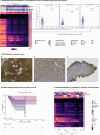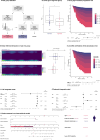Outcome-associated factors in a molecularly defined cohort of central neurocytoma
- PMID: 40498174
- PMCID: PMC12158839
- DOI: 10.1007/s00401-025-02894-3
Outcome-associated factors in a molecularly defined cohort of central neurocytoma
Abstract
Central neurocytomas (CN) are intraventricular brain tumors predominantly occurring in young adults. Although prognosis is usually favorable, tumor recurrence is common, particularly following subtotal resection (STR). Currently, the risk of progression is evaluated using atypical features and an elevated Ki67 proliferation index. However, these markers lack consistent definitions, raising the need for objective criteria. Genome-wide DNA methylation profiles were examined in 136 tumors histologically classified as CN. Clinical/histopathological characteristics were assessed in 93/90 cases, and whole-exome sequencing was conducted in 12 cases. Clinical and molecular characteristics were integrated into a survival model to predict progression-free survival (PFS). A diagnosis of CN was epigenetically confirmed in 125 of 136 cases (92%). No DNA methylation subgroups were identified, but global DNA hypomethylation emerged as a hallmark feature of CN associated with higher recurrence risk. Risk stratification based on histological features of atypia and Ki67 proliferation index was not reproducible across neuropathologists. Hypomethylation at the FGFR3 locus, accompanied by increased FGFR3 protein expression, was observed in 97% of cases. Gross total resection was associated with significantly improved PFS compared to STR, while patients undergoing STR receiving radiotherapy had a better outcome (p = 0.0001). Younger patients were identified as having a higher risk of recurrence (p = 0.026). Patient age and treatment strategy were key factors associated with survival outcomes in this cohort. These findings underscore the importance of closer follow-up for younger patients and radiotherapy for STR cases. Furthermore, FGFR3 represents a hallmark feature and potential therapeutic target, warranting further investigation.
Keywords: DNA methylation profiling; FGFR3; Neurocytoma; Progression-free survival; Radiotherapy.
© 2025. The Author(s).
Conflict of interest statement
Declarations. Conflict of interest: DC and AvD are co-founders and shareholders of Heidelberg Epignostix GmbH.
Figures




References
-
- WHO Classification of Tumours Editorial Board (2021) Central nervous system tumours. International Agency for Research on Cancer, City
-
- Ballard JA, Kercher T, Abraham D, Brecht R, Brooks NA, Buckles T et al (2021) Abstract P141: Preclinical characterization of LOX-24350, a highly potent and isoform-selective FGFR3 inhibitor. Mol Cancer Ther 20:P141–P141. 10.1158/1535-7163.Targ-21-p141
-
- Byun J, Hong SH, Yoon MJ, Kwon SM, Cho YH, Kim JH et al (2018) Prognosis and treatment outcomes of central neurocytomas: clinical interrogation based on a single center experience. J Neurooncol 140:669–677. 10.1007/s11060-018-2997-z - PubMed
Publication types
MeSH terms
Grants and funding
LinkOut - more resources
Full Text Sources
Medical

